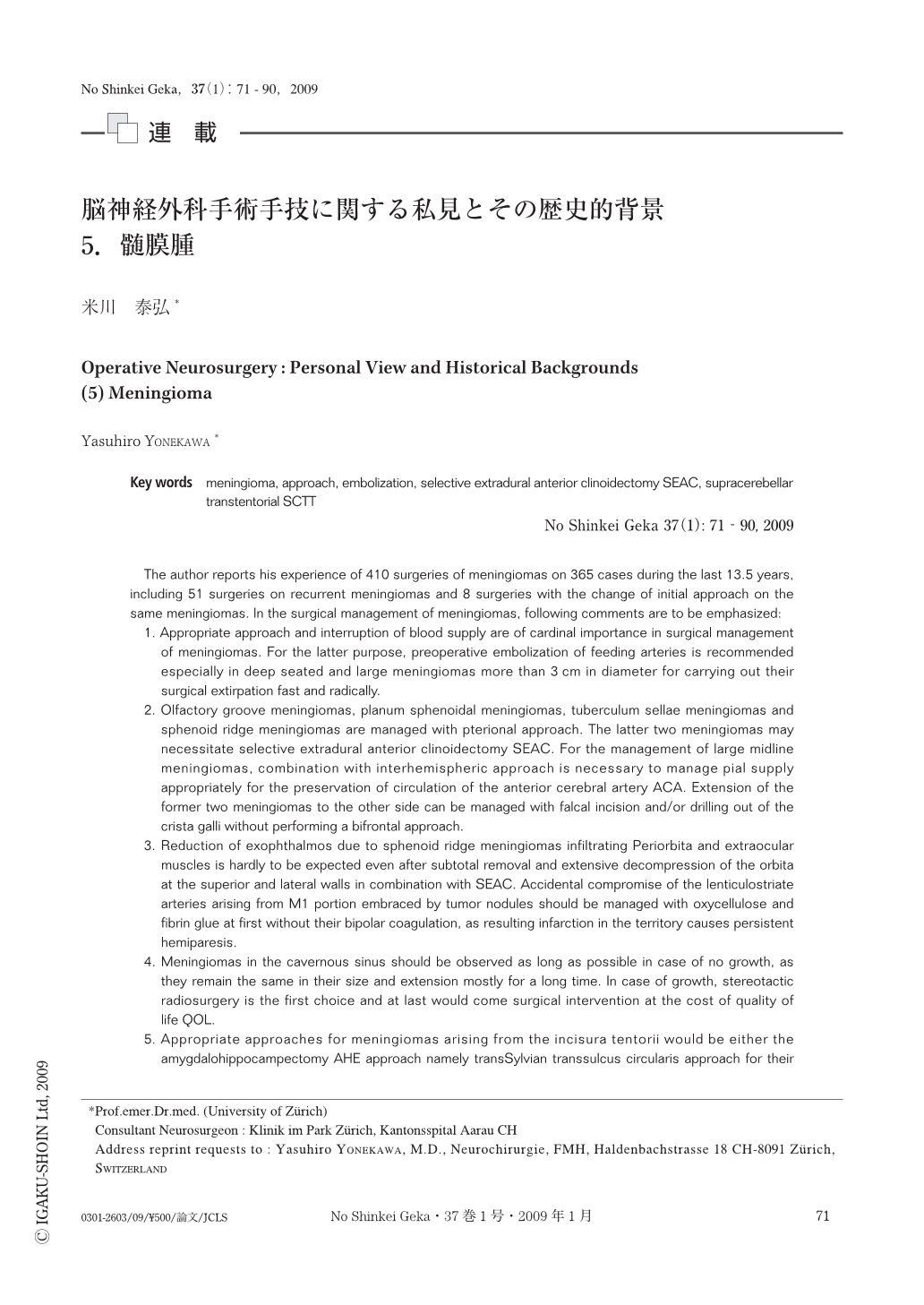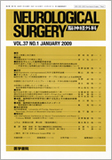Japanese
English
- 有料閲覧
- Abstract 文献概要
- 1ページ目 Look Inside
- 参考文献 Reference
Ⅰ.はじめに
Meningiomaが今回のテーマである.前回39)はselective amygdalohippocampectomy SAHEをお届けしたが,多少このシリーズに興味を示していただいている方々には遅滞をお詫びする.この稿はかなり前に,概要を終えていたのであるが,欧米の脳神経外科教科書,手術書などへの依頼投稿のdead linesが重なり,忙殺されているうちについ日々が経ってしまった.この間に,1996年以来計11回の摘出手術と2回のV-P shunt手術を受け,同時期に放射線治療およびchemotheapyも受けた,30歳を少し超えた女性の患者さんが亡くなった.Meningiomaに関してかつて若い脳神経外科医として持っていた概念〈良性である.一度うまく完全に取ってしまったら,後遺症がなければ完治したと考えてよい〉ははるか彼方に行ってしまっている.Excelで集計して自執刀例がこの13.5年で400回あまりになるのを確認したが,その中で,苦労して全力を尽くしてもうまく行かなかったケースが意外に多かったことが心に残った.
「小さいmeningiomaはgamma knifeに回す」などをはじめとする,教科書に載っているmeningiomaの最近の治療の常識のみでは,御しがたい事柄がいかに多いかを思い知った.それだけに,meningiomaほど,その処理にあたり,脳神経外科医にとっての腫瘍の摘出,除去における基本的な手技が重要視されながら,challengingな側面もはらんでいる腫瘍はないと考える.この稿では,menigioma手術の際のapproachを中心に,著者が留意している事項の一端を延べ,若い先生方に参考にしていただきたいと思う.
The author reports his experience of 410 surgeries of meningiomas on 365 cases during the last 13.5 years, including 51 surgeries on recurrent meningiomas and 8 surgeries with the change of initial approach on the same meningiomas. In the surgical management of meningiomas, following comments are to be emphasized:
1. Appropriate approach and interruption of blood supply are of cardinal importance in surgical management of meningiomas. For the latter purpose, preoperative embolization of feeding arteries is recommended especially in deep seated and large meningiomas more than 3cm in diameter for carrying out their surgical extirpation fast and radically.
2. Olfactory groove meningiomas, planum sphenoidal meningiomas, tuberculum sellae meningiomas and sphenoid ridge meningiomas are managed with pterional approach. The latter two meningiomas may necessitate selective extradural anterior clinoidectomy SEAC. For the management of large midline meningiomas, combination with interhemispheric approach is necessary to manage pial supply appropriately for the preservation of circulation of the anterior cerebral artery ACA. Extension of the former two meningiomas to the other side can be managed with falcal incision and/or drilling out of the crista galli without performing a bifrontal approach.
3. Reduction of exophthalmos due to sphenoid ridge meningiomas infiltrating Periorbita and extraocular muscles is hardly to be expected even after subtotal removal and extensive decompression of the orbita at the superior and lateral walls in combination with SEAC. Accidental compromise of the lenticulostriate arteries arising from M1 portion embraced by tumor nodules should be managed with oxycellulose and fibrin glue at first without their bipolar coagulation, as resulting infarction in the territory causes persistent hemiparesis.
4. Meningiomas in the cavernous sinus should be observed as long as possible in case of no growth, as they remain the same in their size and extension mostly for a long time. In case of growth, stereotactic radiosurgery is the first choice and at last would come surgical intervention at the cost of quality of life QOL.
5. Appropriate approaches for meningiomas arising from the incisura tentorii would be either the amygdalohippocampectomy AHE approach namely transSylvian transsulcus circularis approach for their anterior localization or the supracerebellar transtentorial SCTT approach for the posterior localization in the sitting position. In the latter following structures are to be preserved with great care: A.parietooccipitalis, trochlear nerve, Vena Rosenthal and the superior cerebellar artery which could have considerable supply to the tumor. Meningiomas of the falcotentorial junction are managed also with this approach but may necessitate combination of the suboccipital transtentorial approach large upper clivus meningiomas can be removed more effectively by paramedian or lateral suboccipital craniotomy via SCTT approach in the sitting position rather than the subtemporal transpetrosal approach. Clean and wider operative fields in the former approach are emphasized.
6. Special mention is made to transvertebralis (dural) ring approach TVRA for the foramen magnum or lower clivus meningiomas, in which the vertebral artery can be mobilized without performing more extensive far lateral approach.
7. Difficulties of management of recurrent parasagittal meningiomas with the location corresponding to the gyrus paracentralis plus supplementary motor area are to be emphasized. Role of the venous sinus reconstruction is discussed.
8. Difficulties of management of recurrent meningiomas represented by atypical or anaplastic meningiomas WHO gradeⅡorⅢwhich can not be managed only by surgical removal is discussed by presenting some example cases. Biological activity of meningiomas in different location can be quite different in multiple recurrent meningiomas. Meningiomas intractable to irradiation and/or chemotherapy are another challenging topic, being beyond the scope of this paper.

Copyright © 2009, Igaku-Shoin Ltd. All rights reserved.


